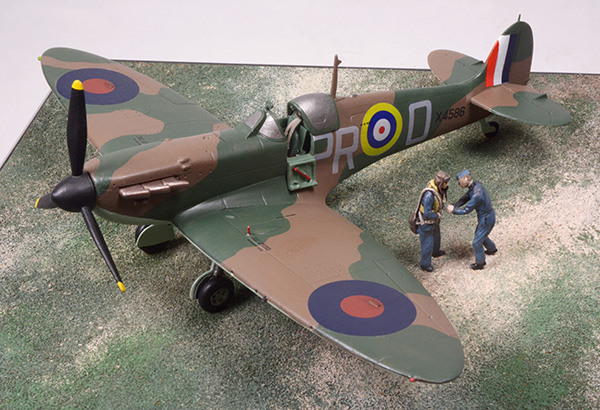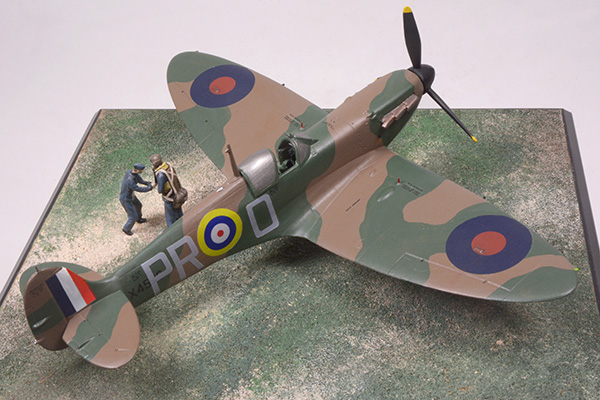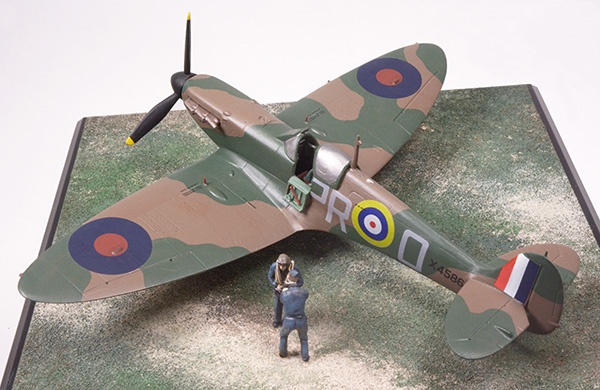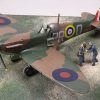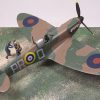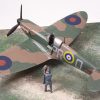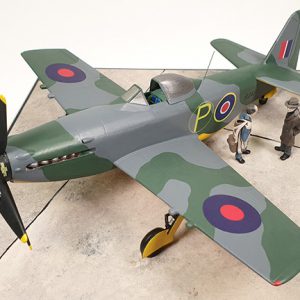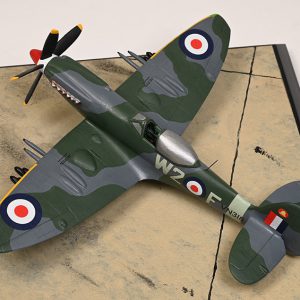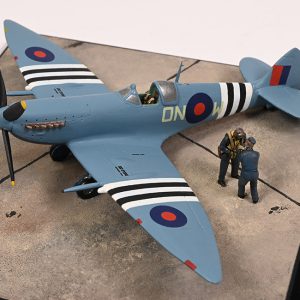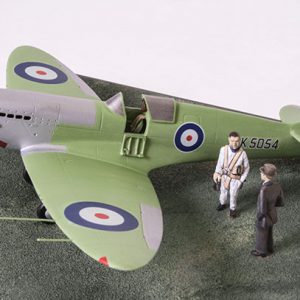Supermarine Spitfire Mk IA X4586 PR-O 609 Squadron
Flt Lt John C Dundas, RAF Warmwell, November 28th 1940
The Auxiliary Air Force came in to being in 1936 as an adjunct to the regular RAF. In many ways it resembled the county Yeomanry. It was an activity to be undertaken in “spare time”, and was organised on a regional basis with strong links to its home areas. 609 Squadron represented the West Riding of Yorkshire and was formed in February 1936 with Sir Harald Peake as Commanding Officer, himself a member of the Yeomanry. 609 received its first Spitfires on the very eve of the outbreak of war. In August 1939, at the outbreak of hostilities 609, like all the Auxiliaries, became incorporated in to the regular air force and like its fellow units retained much of its singular regional character. 609 Squadron had many notable pilots one whom was John Dundas.
John Charles Dundas was born in West Yorkshire on the 19th of August 1915. He was related to two aristocratic families in the region. He was the grandson of a Scottish Liberal and the great grandson of Lawrence Dundas, 1st Earl of Zetland. Dundas was also related to the House of Halifax.
Dundas won a scholarship to Stowe School at the age of 12, and at 17 he won a second scholarship to Christ Church, Oxford. Dundas graduated with a first class degree in Modern History before winning a further award that allowed him to study at both the Sorbonne and the University of Heidelberg.
On leaving University he became a journalist for the Yorkshire Post. He was described as a man indifferent to his personal appearance, who wore frayed trousers, frequently had ink-stained hands and would spill beer over himself when drinking, yet who was also popular with the newspaper’s younger, female staff members.
The newspaper sent him to Czechoslovakia, during the Munich Crisis, as a part of Prime Minister Neville Chamberlain’s entourage in 1938. He then travelled to Rome to report on a meeting between Benito Mussolini, Chamberlain and Lord Halifax, the Foreign Secretary, to whom Dundas was related.
In July 1938, at the age of 23, Dundas was commissioned as a pilot officer in 609 Squadron, which had been set up by his godfather. At that time, the squadron was manned by part-time civilians and was equipped with Hawker Hind bombers. It was converted from a bomber to a fighter squadron and later, in August 1939, re-equipped with the Supermarine Spitfire. John Dundas was well respected by his peers and he frequently flew his commanding officer’s Hind.
Dundas was promoted to the rank of flying officer in January 1940. 609 Squadron was positioned on the south coast of England in May 1940, and was part of RAF Fighter Command operations to provide air cover for the Royal Navy and civilian vessels that were taking part in the Dunkirk evacuation. On the 30th of May, he flew his first patrol. The following day his squadron was put on 30 minutes readiness at RAF North Weald from 12:30 pm. At 14:00 His squadron took off, headed for Dunkirk at 20,000 feet (6,100 m) and engaged the enemy for the first time. In the next patrol Dundas engaged a German bomber formation and destroyed a Heinkel He 111 and a Dornier Do 17. Dundas did not score again during the Battle of France.
Over the next few weeks 609 Squadron moved from Northolt to Middle Wallop. It was from here Dundas gained his first victory of the Battle of Britain, in a phase known as the Kanalkampf. On the 13th of July, as section leader, Dundas led a patrol over a convoy. Failing to find the convoy the Spitfires engaged German aircraft at 15,000 feet (4,600 m) near Portland, England. Dundas led a diving attack out of the sun against Messerschmitt Bf 110s. Dundas claimed a Bf 110 destroyed though the damaged aircraft and its wounded pilot, Leutnant Krebitz, made it back to France, where the Bf 110 was severely damaged in a crash-landing.
On the 12th of August the battle was repeated against Bf 109s and Bf 110s over the same area. Dundas shot down another Bf 110. Shaking off a Bf 109, he damaged another but was forced to disengage as more German fighters closed in and fuel and ammunition had run low. This was his fifth victory and now made him an ace.
A major effort was made by the Luftwaffe on the 13th of August 1940. This was christened Adlertag (“eagle day”), the Germans began a series of heavy air attacks. At 15:30, 609 Squadron was scrambled, At 10,000 feet (3,000 m) Dundas spotted German fighters. His section leader could not see the enemy and instructed Dundas to take the lead. Climbing into the sun at 18,000 feet (5,500 m), Dundas saw Junkers Ju 87 Stuka dive-bombers below him. Attacking he shot down one of the Ju 87s from Sturzkampfgeschwader 2 . Dundas damaged another before being hit. He made a “dead-stick” landing at RAF Warmwell. The German unit that 609 attacked was badly hit. One Staffel (“squadron”) of II./StG 2 lost six out of nine Ju 87s.
In the morning of the 15th of September, a date known as ‘Battle of Britain Day’ he damaged a Do 17, knocking out one of its engines. Flying another Spitfire, X4107, he shared a Do 17 with his wingmen, Pilot Officer Mike Appleby, and the American pilot Vernon Keogh.
On the 7th of October Dundas claimed a probable victory against a Bf 110, after a battle with German aircraft six miles north of RAF Warmwell at 16:30. Despite firing a 12–14 second burst at the enemy fighter, he did not see it crash. During the battle Dundas was hit in the leg when a cannon round exploded in his cockpit, but flew again the next day. The Spitfire Dundas flew that day, R6915, still exists, having been preserved by the Imperial War Museum. By the 9th of October 1940, his score stood at 10 and he was award the Distinguished Flying Cross.
By now Dundas was recognised as 609 Squadron’s highest scoring pilot, he was highly regarded by his comrades and was well-liked. He passed on experience to younger pilots and was always willing to discuss tactics, particularly with Squadron Leader Michael Robinson. Dundas, even by this early stage in the war, was the only member of the original auxiliary pilots still with 609. Dundas lamented the few who remained were the “sole champions of the Auxiliary attitude”.
The 28th of November, was a busy day for 609 Squadron. Several scrambles and alerts came through against Bf 109s, the last at approximately 15:30. Dundas was once again piloting X4586. Two squadrons, 152 Squadron and 609 made contact with Bf 109s from Jagdgeschwader 2, led by the most successful German ace of the war thus far – Geschwaderkommodore Helmut Wick flying his Bf 109E-4 ‘<-+-‘. Minutes after contact had been made and the battle joined, Flight Lieutenant Fieldsend heard the familiar voice of Dundas shout “I’ve finished a 109 – Whoopee!”. Squadron Leader Robinson congratulated Dundas but nothing was heard from Dundas, or his wingman Pilot Officer Paul A. Baillon, flying R6631.
It is believed Wick had shot down Baillon in a diving attack for his 56th aerial victory. Baillon managed to bail out, but was never recovered. Momentarily distracted, Wick flew across Dundas’ path. Dundas fired a short burst, hitting Wick’s 109, over the sea near the Isle of Wight. Wick was seen to bail out of his aircraft, but he was not rescued and his body was never found. Moments later Dundas was shot down by Wick’s wingman, Rudolf Pflanz who claimed a victory and saw the Spitfire crash into the sea with the pilot still inside. Like Wick, Dundas’ body was never found. On the 24th of December 1940, Dundas was posthumously awarded a second DFC. It was announced on the 7th of January 1941 in the London Gazette with the citation :
“Flight Lieutenant Dundas has continued to engage the enemy with outstanding success and has now destroyed at least twelve of their aircraft and damaged many more. On one occasion he pursued an enemy aircraft from Winchester to Cherbourg, finally destroying it. He has shown a magnificent fighting spirit which has inspired the other members of his flight”.
As an airman who has no known grave, he is commemorated on the Air Forces Memorial at Runnymede. A small memorial to Dundas is on a cliff-top path east of Freshwater Bay on the Isle of Wight, close to the point where his final battle took place. It was installed in November 2000, on the 60th anniversary of his death.
X4586 made its first flight on the 29th of September 1940, and was delivered to 609 Squadron on the 8th of October. When it was shot down on the 28th of November it had logged 37 hours 55 minutes flying time.
Dundas’ younger brother Hugh was also a fighter pilot. Hugh was wounded in August 1940 but recovered and eventually rose to the rank of group captain. He survived the war and died in 1995.


